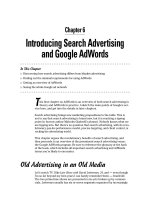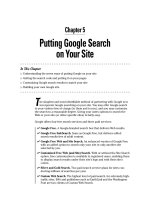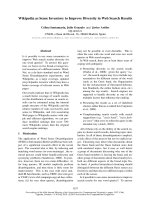Diversity HERC Roleof Search Commin Recruitingamore Diverse Faculty Powerpoint
Bạn đang xem bản rút gọn của tài liệu. Xem và tải ngay bản đầy đủ của tài liệu tại đây (539.55 KB, 32 trang )
Recruiting a More Diverse
Role
of
Search
Faculty…
Committee
1
John T. Rose
April 14, 2010
Recruiting Diverse Faculty Requires:
Leadership from the President, Provost and Dean
Support from the Academic Community
Pro Active Sourcing
Allocating and investing resources to get ahead
of the curve.
Clear evaluation criteria and checkpoints
On-going CDO advice and guidance
3
CDO Role
Educator
Collaborator/Persuader
Facilitator
Catalyst
4
Dispelling Myths
Diversity
Not about hiring quotas, or showing preference to
particular groups
Allows the best use of talent
Removing barriers and providing equal access
and equal opportunity
Sometimes those barriers are subtle or
subconscious
5
Institutional Goals
Faculty should represent the availability of qualified
candidates from each protected group
Use federally-mandated data, on PhD’s in each
discipline
6
Myths About Hiring And
Faculty Diversity
“Relatively few qualified minority candidates
are available, and these are highly sought-after,
so we are unlikely to recruit them.”
“We are doing everything we can, so the
situation is already the best it can be.”
Although availabilities differ, in most cases HEI’s
are not hiring faculty anywhere close to the
proportion that are available
Data suggest that minorities are not sought-after
7
Myths About Hiring And Faculty
Diversity
We only use quality as a criterion for hiring. Adding
diversity will therefore compromise quality.
Quality can be hard to define, and can be applied
differently to different groups
Unconscious biases influence our evaluations
Example: Name Bias
8
Key Steps of Recruiting Process
Sourcing Candidates: The Position Description
Defining the Position
Determining Rank
Determining Qualifications
Advertisement Language
10
Position Description (Defining)
Job descriptions Should Have Broad Description of
Commitment to Scholarship, Experience and
Disciplinary Background.
Should Label Qualifications as “Preferred”, instead
of “Required” and use “should” instead of “must”
Where possible, Years of Experience Should be
Flexible.
For example, in some disciplines Academic
Credentials plus experience as a corporate or
NGO executive might add more value than
instructional experience alone
Open Rank Provides Flexibility
11
Position Description (Advertising Signals)
The type of language used in the position description
may be important to attracting Diverse Candidates.
For Example, Some Colleges Use Phrases Such As:
“We are seeking candidates who have a strong
commitment to teaching undergraduate and graduate
students from diverse cultural backgrounds”
“We are strongly committed to achieving excellence
through cultural diversity”
12
Position Description (Advertising signals)
“Demonstrated Success In Working With Diverse
Populations”.
“Experience Interacting With Diverse Populations or
Students of Color”.
“Academic Experiences With Culturally Diverse
Populations”.
“Interest In Developing and Implementing Curricula Related
to Culturally Diverse Populations”.
“Experience With a Variety of Teaching Methods”.
13
The Search Committee
Composition
Charging & Orienting Search Committee
Developing a timeline
Developing selection criteria
Generating a diverse candidate pool
14
Search Committee (Selection Criteria)
Develop search screening protocol to assure
fairness, consistency and uniformity
Consider Departmental/Institutional needs broadly
value research and creative endeavors that reflect
diversity
recognize importance of diverse mentors as role
models for student
value experience and instructional approaches
which will promote cultural competence
15
The Search Plan
Cast a wide net
Broaden Pool
Use multiple, simultaneous recruitment strategies.
Use M/W Journals, Publications, Assocs
Move from Traditional to Active Recruiting.
16
Search Plan-Active vs. Passive
Beyond reliance on postings (Passive) Search
Committee should actively engage in networking
and other outreach efforts to generate a pool of
diverse candidates, including:
Mailings to academic discipline minority caucus and to other special interest
groups
Phone contacts with leadership of diverse professional association, academic
discipline minority caucus or other minority organization
Personal approach to potential applicants at academic conferences or
professional meetings to encourage applications
Consultation with minority faculty on Campus about effective outreach strategies
Identify possible candidates in the academic discipline through MWMD Directory
and other resources
Personal letters inviting candidates to apply and/or to refer others
Recruiting trips to University that have high minority PhD graduates
Identify those in your discipline who maintain diverse networks
(“Gatekeepers”) and ask for referrals
17
Candidate Evaluation- Making
the Short List
Determining short list criteria
Developing short list candidates
Use of multiple short lists
18
Making the Short List
Screen for relevancy, fairness and consistency;
but don’t overlook non-traditional experience
Create clear criteria in advance for discussing
candidates
Be aware of potential bias towards candidate with
degrees from Ivy/Elite schools
Look beyond publication record to other measures
of academic merit—teaching excellence, work
experience, service and outreach
Create “short’ list for each selection criteria and
consider developing “medium” list, if necessary
19
Search Committee- Mistakes to
Avoid
Assuming there are no Diverse Candidates in
the Pipeline for your discipline
Failure to spend time analyzing factors that
determine why Diverse Candidates do not apply.
Not soliciting the experiences and perceptions
of Diverse Faculty that have been hired
Greater scrutiny of Diverse applicant credentials
- Credentials must be from Elite or Ivy League
Universities
“King of the Hill” and “Queen Bee” Syndrome
Unconscious Bias - desire to hire people “who
are like us”.
20
Quality is Subjective: The
Myth of Pure Merit (Cont’d)
Unconscious biases influence our evaluations
Example: Recommendation Focus
& Psenka 2003 Study)
letters for women were shorter
letters for men focused on different skills
(Trix
21
Gender Differences In Faculty
Recommendations
22
Gender Differences In Faculty
Recommendations
23
Letters of Recommendation:
Differences By Gender
Most common phrases for women:
Her training
Her teaching
Her application
Most common phrases for men:
His research
His skills and abilities
His career
By this measure, men are portrayed more as
researchers and professionals.
24
Candidate Evaluation
Handling the Campus Visit and Evaluating Finalists
Consider Communications 2-Way
Determine evaluation criteria in advance
Arrange interviews, demos and job talks
Consistency of opportunity (time, formatting, space,
technology, attendees)
Ask uniform interview questions
Follow-up may be different
Gather equivalent info on all candidates
Seek feed back on specific issues or facets of
candidate’s performance/potential
25
Candidate Evaluation (Consistency)
Make sure uniform questions properly examine
knowledge, skills, experience and temperament in a
variety of settings
Provide template or evaluation forms so Search
Committee can rate each candidate both on answers to
Q’s and overall
Be aware of potential hidden bias
Ivy/Elite Education
candidate thinks “like us”
candidate “looks” like a fit or “won’t be happy here”
Think carefully about what constitutes excellence in a
candidate
value of non-traditional career paths
non-traditional research interests or publications
record of or willingness to engage in community service with diverse populations
26
Candidate Evaluation (Campus Visit)
Demonstrate Sincere Interest In Candidate.
Allow candidate to understand Departmental research,
teaching and service expectations.
Identify Diverse and Majority Faculty who have similar
scholarly interests so candidate may follow-up
Provide an itinerary that allows candidate to get a feel
for College’s Diverse Campus and College Community
(Faculty/Students)
Anticipate areas of likely inquiry (culture/climate,
service/governance responsibilities/opportunities,
departmental relations) to marshal thoughtful response
Provide contextual information so candidate can make
informed decision as to “fit”
27









